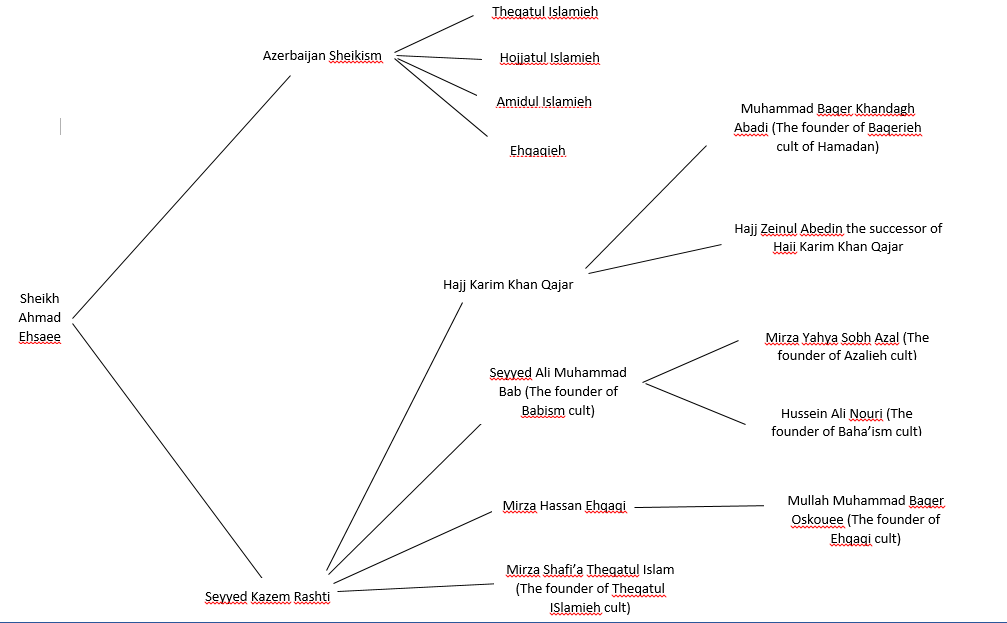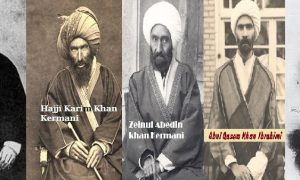All the followers of Sheik Ahmad Ehsaee are called Sheikism which is a generic name. Sheikh Ahmad Ehsaee was born in 1166 A.H. in Bahrain (The Northeast of the Saudi Arabia)[1]. He learned the holy Quran and the rudimentary sciences in his birthplace. In 1186 A.H. when he was 20 years of age, he went to Najaf and Karbala cities to continue his education learned by Agha Baqer Vahid Behbahani (1205 A.H.), Agha Seyyed Mahdi Bahrul Oloum and Kashiful Qeta’ and Seyyed Ali Tabatabaee the author of Riyadh. He became scholar in religious jurisprudence when he wrote an interpretation of the great scholar Helli.[2]
After residing in Najaf and Karbala cities for 23 years, he returned to Bahrein in 1209 A.H. He traveled to Iran at that year to visit Imam Reza’s (P.H.) holy Shrine as pilgrimage. Then, he came back from Mashhad and went to Yazd city and resided there for five years. He went to Tehran city insisted by Fath Ali Shah Qajar because he had become famous. After residing in this city for a while, he moved to Iraq; but The rule of Kermanshahan made him stop there and he resided there till the ruler of that city died. After the ruler’s death, Sheikh went to Najaf and Karbala. Sheikh Ahmad got famous during several trips he took to Iran. After a while, he came back to Iran. After visiting the holy Mashhad as pilgrimage, he wanted to go to Iraq. In Qazvin city, he was excommunicated by the scholars of this city after arguing with them about resurrection. That was a start for a long-termed debate among the Shias. He was excommunicated by Muhammad Taqi Baraqani (the third martyr); so he went to Hijaz. He died when he was in his way to Medina and was buried there.[3]
Sheikh Ahmad Ehsaee has written many books in jurisprudence, philosophy, literature and etc. he posed his views concerning three issues:
۱- The resurrection issue: Sheikh Ahmad Ehsaee believes that at the time of resurrection, the physical body of human being won’t come back, but just the Hourqoliyaee body will return. It is worthy to be explained that some philosophers in the past believed that returning body in resurrection is impossible. Merely the human spirit will come back.[4]
To solve the above-mentioned doubt, Sheikh Ahmad Ehsaee posed the issue of “Hourqoliya”. To him, human being possesses an elemental body and a Hourqalyaee body, too. As stone includes miral and after the stone being melted, miral will be extracted, the Hourqoliyaee body is in the elemental body and at the time of resurrection just the very Hourqaliyaee body will return, not the elemental body[5]. This thesis made Ehsaee be excommunicated by Muhammad Taqi Baraqani known as the third martyr.
۲- Ascension: It was said in the ancient philosophy in part physics that the world consists of nine heavens on which it was said that the holy prophet’s (P.H.) ascension would cause heavens if it were physical, so they were saying it was spiritual. Sheikh Ahmad Ehsaee posed a new thesis to remove the doubt based on which he said the holy prophet (P.H.) had obtained the body in accordance with that heaven… Of course, the mentioned doubt and Sheikh Ahmad’s thesis for solving it were both wrong.
۳- Cracking the moon miracle: It has been said that Sheikh Ahmad didn’t believe in the moon to be cracked by the holy prophet –peace be upon him- and he was saying it has been originated from the abstracted form of the moon[6].
۴- Exaggeration about the Household of the prophet –peace be upon them. It has been said that Sheikh Ahmad Ehsaee has exaggerated about the Household of the prophet and has attributed something to them which are belonged to God specially. For instance, he believed that God has delegated and entrusted everything in the existence to the holy Imams –peace be upon them- such as creature, susteinance, life, death and etc. Additionally, he believed that the holy Imams’ sciences aren’t acquired.[7]
Anyway, such beliefs caused Sheikh Ahmad to be put in a path to be the head of a new creed. To be honest, Ehsaee wasn’t to establish a new creed and school or religion and he didn’t counteract after being excommunicated by Sheikh Muhammad Taghi Baraqani and headed off to Karbala, Najaf and then to Hijaz to resolve the differences and conflicts. For this reason, some Shia scholars have praised him and some have said he had made mistakes due to not having a seasoned master or not reading philosophy[8]. Because Ehsaee was a powerful scientist and was loved by his pupils, he was misused by opportunities such as Seyyed Kazem Rashti who misused the opportunities after his master’s death and founded Sheikism or Kashfieh creed misusing his master’s popularity[9]. Consequently, Seyyed Kazem Rashti can be considered as the founder of Sheikism creed not Sheikh Ahmad Ehsaee.
After Seyyed Kazem Rashti, Sheikism cult divided into the following cults due to his pupils’ differences.
Seqatul Islamieh, Hojjatul Islamieh, Amidul Islamieh, Ehqaqieh, Sheikism of Kerman and Sheikism of Hamadan.

[۱] Mashkour, Muhammad Jawad, the dictionary of the Islamic cults, the foundation of Islamic researches of Radhavi holy threshold, p. 266.
[۲] Zahed Zahedani, Seyyed Saeed, Baha’ism in Iran, pp. 120 & 122.
[۳] Khansari
[۴] Khodaee, Ahmad, the analysis of the history and beliefs of Sheikism cult, Qom, Amirul Elm publications, 2nd edition, 1382 S.H., p. 49.
[۵] Sobhani Seyyed Ja’far, Al-Mazahebul Islamieh, Qom, Imam Sadeq (P.H.) institute publications, 1st edition, 1423 A.H., p. 355.
[۶] Ibid, p. 355.
[۷] The Islamic Religions, p. 355, Rowzatul Jannat, Vol. 1, pp. 88-94.
[۸] The dictionary of Islamic cults, p. 367.
[۹] Mirza Muhammad Agha Muhammad Agha Theqatul Islam, lifetime events or the historical works, Tabriz, Rezaee publishing house, 1340 S.H., pp. 14, 51, 54, 84, 85 and 86…






